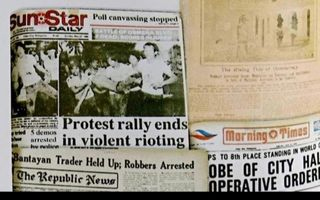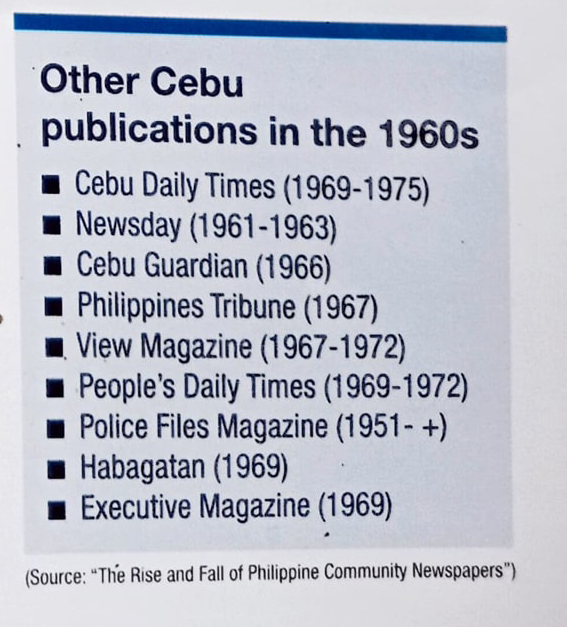Standing Tall: The Cebu dailies that survived the eighties

Former office buildings of The Freeman, across the street from its present building at D. Jakosalem and P. Gullas Sts., and Sun.Star Daily (renamed SunStar Cebu), along Osmena Blvd., a block away from its own building on P. del Rosario St.
Standing Tall: The Cebu dailies that survived the eighties
LINETTE RAMOS-CANTALEJO
2012 (CJJ7) [Last updated: January 2023]
Four dead, two survive contest. If there was a publication covering the newspapers in the 1980s, the fall of three local dailies in a span of two years would have made headlines. And so would the success of two other dailies.
AT the start of the decade, five local dailies were in circulation: The Freeman, Visayan Herald, Republic News, Cebu Advocate and Morning Times. Barely halfway into the decade, three already folded up as the others struggled to survive amid challenging times. Cebu Advocate started in 1965 by Cesar A.V. Aleonar, who owned a small printing press. The paper started to have problems when Aleonar got sick in 1978 and died in 1982. Finally, in 1984, it shut down operations after the military identified one of its columnists as a dissident, said Manuel Satorre Jr. in the 1993 book “The Rise and Fall of Philippine Community Newspapers.”
Guerilla paper; anti-FM ‘Republic’
Morning Times folded up in the same year for similar reasons. What started as a guerilla newspaper became successful in the 1960s under Pedro D. Calomarde (1905-1986) as publisher. BY 1971, he had 16 people operating the paper’s letterpress and linotype, with four people running the editorial department. Six years later, the paper’s struggles started when Calomarde suffered a heart attack. His second wife and children fought over control of the paper. By 1984, the paper had to close.
A year later, Republic News also shut down. Publisher Dioscoro B. Lazaro (1918-1999) was on top of the operations when the owners, the Cuencos, took control of the paper in 1983. When Jesus Cuenco started sitting as publisher, trouble began, Satorre said. Jesus is the brother of former Cebu City congressman Antonio Cuenco, who was political affairs minister in the ‘80s.
The veterans were eased out “and replaced with aspiring journalists who could be dictated by the paper’s political creators,” Satorre said.
Republic News began running articles critical of the Marcos administration, sometimes bordering on libel, replacing what Satorre said were once balanced views of the paper. As a result, advertisers got scared, so advertising and circulation dropped, forcing the owners to shut down operations in 1985.
Herald’s problems
Visayan Herald, put up by retired public school supervisor Alejandro “Al” Alinsug in 1978, followed suit and eventually closed. In “Cebu Media History: Evolving through 100 years 1905-2005,” journalist Godofredo M. Roperos said the Herald succumbed to management problems.
The stories of these once-patronized dailies provide lessons for publishers and newspaper managers.
Satorre said a paper’s survival should not be left to a single individual because if that publisher or manager goes, so does the paper. Also, papers motivated by things other than journalism—those that operate to protect the political and financial interests of its backers—and papers not run as a business venture are bound to fail.
How to survive
“They will survive only for as long as they remain useful to the owners and are subsidized. If subsidy is withdrawn, the paper can fall. If the reading public withdraws its patronage because the paper has practically become a political organ and has lost is credibility, then it will have to fold up. To survive, a paper should therefore be run both as a business venture and as a vehicle to serve the information needs of the community,” Satorre said.

Two dailies that survived (SunStar and The Freeman) and two of the four that did not.
But there were also success stories.
The Freeman — founded in 1919 by Paulino Gullas (1891-1945), a lawyer and assemblyman, and his brother Vicente, an educator – went out of publication just before World War II. The name of the paper was adopted when Vicente’s son Jose R. Gullas, one of the owners of the University of the Visayas and former Cebu congressman, decades later, in 1965, opened a weekly magazine. In 1969, the new Freeman became a six days-a-week daily and in 1972, it increased its frequency to a full-week daily. It has continued to be in circulation today.
Freeman’s success
Its founding editors were lawyers Pachico A. Seares, Romulo Senining, both alumni of the Gullas Law School, and Jose Gullas. When Seares, credited for developing the mass appeal of the paper, left it in 1982, The Freeman was No. 1 in circulation and readership among the Cebu papers, besting the former king of the bloc, Republic News.
Despite being padlocked by the military in 1972, The Freeman survived Martial Law to become one of only two newspapers that remained in circulation at the close of the 1980s.
In “The Rise and Fall of Philippine Community Newspapers,” Dr. Crispin Maslog counts the ample financial resources of the Gullases — who also own Cebu’s largest university — the paper’s editorial prudence, and its choice of editors and reporters as among the reasons behind the Freeman’s success.
Although owned by a family of politicians, the Freeman, he said, maintained its independence.
“In a city where newspapers appeared to be split along political lines, the Freeman, under Seares (its editor for 17 years), remained independent. … It has shown fairness and fair play in the presentation of news. The paper has also adhered to ethical practices in Journalism,” Maslog wrote. (“The Freeman: A Cebu Pioneer” by Crispin C. Maslog]
This independence, he adds, was made possible by the owner’s financial backing, in the form of capital and modern printing facilities, and a free hand in running the paper. Hence, the paper had no reason to give in to pressure from advertisers and politicians, allowing it to keep the readers’ and advertiser’s loyalty.
SunStar’s formula
In 1982, Sun.Star Cebu joined the media fray and has since managed to gain the trust of the community, owing largely to the integrity and credibility that its pool of editors and reporters strives to keep.
To Seares, who was Sun.Star Cebu editor-in-chief for 28 years (1982 to 2010), “having the right people to run the paper, the amount of independence they’re given to run it, adherence to truth, fairness in reporting and sobriety in opinion-making, enterprise, courage, espousing the causes of the oppressed and prodding government on vital services, among others,” contribute to the paper’s integrity and credibility and in gaining public trust. [“SunStar: A Cebu Success Story” by Pachico A. Seares]
To the last two papers standing, it was also about timing and the environment: coming in at a time or rapid economic growth, which meant more money for advertisements, and a rising readership base that allowed the papers to grow. 

